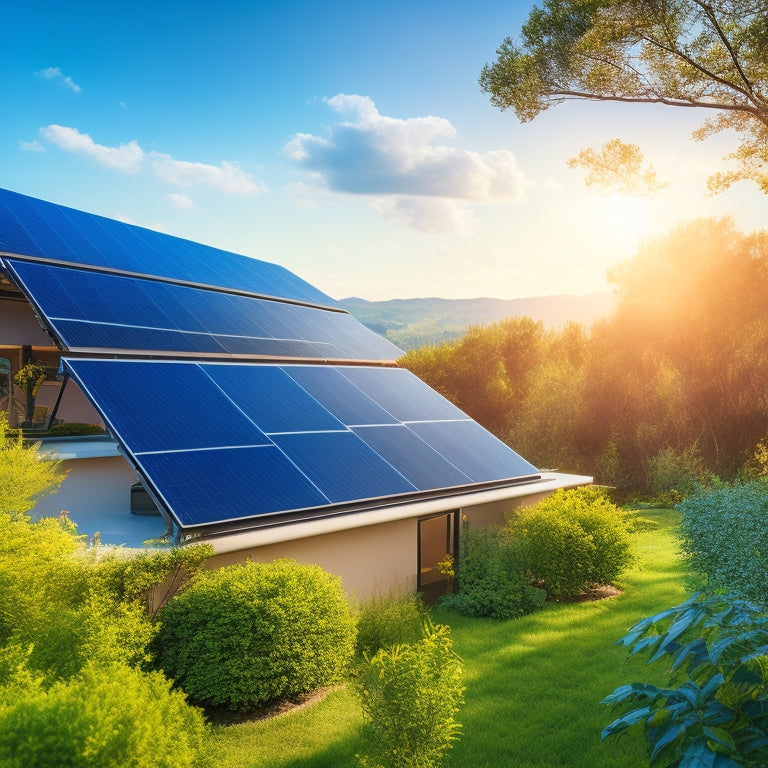
Top Home Solar Systems for Maximum Energy Efficiency
Share
You're looking for top home solar systems that maximize energy efficiency, and to achieve that, you need to focus on systems that excel in four key areas: high-efficiency solar panels, optimized inverter technologies, effective energy storage systems, and smart mounting and tracking solutions. SunPower and Panasonic offer high-efficiency panels, while Trina and Jinko provide affordable alternatives. String inverters are cost-effective, but micro inverters convert power from individual panels. Energy storage systems like lithium-ion batteries store excess energy, and proper mounting and alignment are essential for maximizing energy capture. Now, explore deeper into the specifics to find the perfect system for your energy needs.
Key Takeaways
- High-efficiency solar panels with ratings over 20% can significantly increase energy production and reduce installation costs.
- Inverters with 95-99% efficiency, such as string, micro, and hybrid inverters, ensure optimal energy conversion from DC to AC power.
- Durable module design, materials, and manufacturing quality are crucial for withstanding environmental stressors and ensuring long-term performance.
- Energy storage systems (ESS) with lithium-ion batteries or other options can store excess energy for later use, enhancing energy independence and savings.
- Proper mounting and tracking systems, such as solar trackers, can increase energy output by up to 45% compared to fixed mounts, maximizing energy capture.
Understanding Energy Efficiency Ratings
When considering a home solar system, understanding energy efficiency ratings is essential in evaluating the performance of various solar panels and systems. You'll want to know how efficiently a system converts sunlight into usable energy. Energy efficiency ratings help you compare different systems and make informed decisions about your energy consumption.
Efficiency standards, such as those set by the National Renewable Energy Laboratory (NREL), provide a benchmark for evaluating solar panels and systems. Look for ratings like the Photovoltaic Efficiency (PV) rating, which measures a panel's ability to convert sunlight into electricity. A higher PV rating indicates greater energy efficiency.
Additionally, consider the system's capacity to reduce energy consumption. A more efficient system will generate more power per hour of sunlight, reducing your reliance on the grid and your energy bills.
When evaluating energy efficiency ratings, consider factors like temperature coefficients, which affect a panel's performance in high temperatures. A lower temperature coefficient indicates better performance in hot conditions.
Top Solar Panel Manufacturers
You'll want to contemplate solar panels from leading brands, known for their efficient cell technology and durable module designs.
These top manufacturers have established themselves through rigorous testing and quality control, ensuring their products meet high standards.
Leading Panel Brands
Selecting the right solar panel brand is an essential step in utilizing the power of the sun for your home. You want a brand that offers superior quality, durability, and energy efficiency.
Leading panel brands have made notable advancements in solar panel innovations, continually pushing the boundaries of what's possible. When comparing brands, you'll notice that each has its strengths and weaknesses.
For instance, brands like SunPower and Panasonic are known for their high-efficiency panels, while others like Trina and Jinko offer more affordable options without sacrificing too much on performance.
You'll also find that some brands, such as Tesla, focus on integrating their panels seamlessly with energy storage systems.
When making your decision, consider factors like warranty length, customer support, and the quality of materials used. By assessing these factors and comparing the top brands, you'll be able to find the perfect fit for your home's energy needs.
Efficient Cell Technology
High-efficiency solar panels rely on advanced cell technologies to maximize energy output. You need to understand the latest solar cell advancements to utilize the most power from your rooftop installation. Efficient cell technology is vital for ideal energy conversion, and top manufacturers are constantly innovating to stay ahead.
| Manufacturer | Cell Technology | Efficiency Rate |
|---|---|---|
| SunPower | Maxeon Cells | 22.8% |
| Panasonic | HIT-240 Cells | 21.8% |
| Trina Solar | Duomax Cells | 21.5% |
| LG Solar | NeON Cells | 21.1% |
| Hanwha Q CELLS | Q.ANTUM Cells | 20.9% |
These industry leaders have developed state-of-the-art cell technologies that greatly enhance energy conversion rates. By leveraging these advancements, you can generate more power per hour of sunlight, reducing your reliance on the grid and your carbon footprint. When selecting a solar panel system, prioritize efficient cell technology to get the most out of your investment.
Durable Module Designs
Three key factors contribute to a solar panel's overall durability: module design, materials, and manufacturing quality.
When you're looking for a top-performing home solar system, it's crucial to evaluate these factors to guarantee maximum energy efficiency over the system's lifespan.
Durable module designs are critical to withstanding various environmental stressors, such as extreme temperatures, humidity, and weather conditions.
Top solar panel manufacturers incorporate innovative design features to enhance durability, including:
- Anodized aluminum frames that provide exceptional corrosion resistance
- Tempered glass or polymer sheets that protect the photovoltaic cells from damage
- Weather-tight seals that prevent moisture ingress
- Robust mounting systems that securely fasten the panels to your roof
- Integrated drainage systems that prevent water accumulation and reduce the risk of damage
Inverter Technologies Compared
Your solar panel array generates DC power, but your home requires AC power to function. That's where inverters come in – to convert DC power into usable AC power. There are several inverter technologies to evaluate, each with its strengths and weaknesses.
| Inverter Type | Description | Efficiency | Lifespan |
|---|---|---|---|
| String Inverter | Converts DC power from entire array | 95-98% | 10-15 years |
| Micro Inverter | Converts DC power from individual panels | 95-98% | 25 years |
| Hybrid Inverter | Combines string inverter and power optimizer | 97-99% | 10-15 years |
When choosing an inverter, assess factors like inverter efficiency, lifespan, and cost. String inverters are the most common and cost-effective option, but micro inverters offer greater flexibility and monitoring capabilities. Hybrid inverters provide a balance between the two. Power optimizers can be added to string inverters to enhance performance. Ultimately, the best inverter for you will depend on your specific system design and energy needs.
Energy Storage System Options
As you contemplate your home solar system, incorporating an energy storage system (ESS) can greatly enhance its overall performance and value.
An ESS allows you to store excess energy generated by your solar panels during the day for use during the night or when the grid is down. This not only provides backup power but also enables you to optimize your energy usage and reduce your reliance on the grid.
When selecting an ESS, you'll need to evaluate the type of battery, its capacity, and its compatibility with your solar system. Here are some key factors to keep in mind:
-
Lithium-ion batteries: Most common type of battery used in ESS, known for their high energy density and long lifespan.
-
Lead-acid batteries: More affordable option, but heavier and less efficient than lithium-ion batteries.
-
Flow batteries: Well-suited for long-duration energy storage, but less common in residential applications.
-
Sodium-ion batteries: Emerging technology, potentially more cost-effective than lithium-ion batteries.
-
Grid integration: Verify your ESS is designed to work seamlessly with the grid, allowing you to sell excess energy back to the utility company and providing a reliable source of power during outages.
Mounting and Tracking Systems
How efficiently will your solar panels capture the sun's energy if they're not properly mounted and aligned?
You've invested in top-quality solar panels, but without a reliable mounting and tracking system, you're leaving energy on the table.
Fixed mounts are a cost-effective option, ideal for roofs with minimal shading and obstructions. They're easy to install and require minimal maintenance.
However, they're fixed at a single angle, which means they can't adapt to changing sunlight patterns throughout the day.
Solar trackers, on the other hand, are designed to maximize energy output. They adjust the panel angle to track the sun's movement, guaranteeing optimal energy capture.
While they're more expensive than fixed mounts, solar trackers can increase energy production by up to 45%.
When choosing between fixed mounts and solar trackers, consider your roof's layout, local building codes, and energy goals.
Monitoring and Maintenance Tools
The performance of your home solar system relies heavily on real-time monitoring and regular maintenance to guarantee ideal energy production.
You need to stay on top of your system's performance to make sure you're generating the maximum amount of energy possible. This is where monitoring and maintenance tools come in.
To get the most out of your system, you'll want to employ tools that provide:
- Real-time monitoring of energy production and consumption
- Solar performance analytics to identify areas for improvement
- System health monitoring to detect potential issues before they become major problems
- Automated alerts and notifications for maintenance and repair needs
- Data tracking and analytics to optimize system performance over time
Cost and ROI Analysis
What's the true cost of owning a home solar system, and how does it impact your return on investment (ROI)? As a homeowner, you're likely considering various financing options to make your solar dreams a reality. The initial investment can be substantial, but it's crucial to look beyond the upfront costs and consider the long-term benefits.
Here's a breakdown of the typical costs associated with home solar systems:
| Cost Component | Average Cost |
| Installation Costs | $15,000 - $30,000 |
| Equipment Costs | $10,000 - $20,000 |
| Permits and Inspections | $1,000 - $3,000 |
| Maintenance and Repairs | $500 - $2,000 |
As you can see, installation costs make up a significant portion of the overall expense. However, with the right financing options, you can spread the cost over time and start seeing a positive ROI within a few years. By generating your own clean energy, you'll reduce your reliance on the grid and lower your utility bills, ultimately increasing your ROI.
Local Incentives and Rebates
Beyond the federal tax credit, local incentives and rebates can considerably reduce the upfront cost of your home solar system.
You'll want to investigate these options to maximize your savings.
-
State rebates: Many states offer rebates for solar installations, which can range from a few hundred to several thousand dollars.
-
Local programs: Municipalities and counties may offer additional incentives, such as property tax exemptions or low-interest loans.
-
Utility incentives: Your utility company may provide rebates or credits for installing solar, especially if you participate in their net metering program.
-
Financing options: Look for local financing options, such as Property Assessed Clean Energy (PACE) financing, which can help spread the cost over time.
-
Community solar: If you can't install solar on your own property, consider joining a community solar program, which may offer discounts or incentives.
Frequently Asked Questions
Can I Install Solar Panels on a Metal or Clay Tile Roof?
You'll need to evaluate installation factors and roof compatibility when deciding whether to install solar panels on a metal or clay tile roof; verify your chosen system is compatible with your roof's material and structure to maximize energy efficiency.
How Do Solar Panels Perform in Extreme Weather Conditions?
Can you really expect your solar panels to withstand the fury of Mother Nature? You'll be relieved to know that modern solar panels are engineered for durability, boasting extreme weather resilience, and are designed to perform efficiently even in the harshest conditions.
Are Solar Panels Resistant to Hail and Other Debris?
You'll be relieved to know that most solar panels are designed with hail resistance and debris protection in mind, using tempered glass or durable materials that can withstand impacts from hailstones up to 1 inch in diameter.
Can I Expand My Solar Panel System in the Future?
You'll be thrilled to know that you can basically future-proof your energy needs by designing a scalable solar system that effortlessly accommodates expansions as your energy demands grow, ensuring you're always powered up and ahead of the curve!
Do Solar Panels Void My Roof's Warranty?
You're wondering if solar panels void your roof's warranty; typically, they don't, but it depends on the roofing materials and solar panel warranties in place - review your contracts to confirm compatibility and avoid potential issues.
Conclusion
As you weigh your options, remember that top-tier home solar systems aren't just about generating electricity - they're about maximizing energy efficiency. On one hand, you'll want to utilize the power of the sun with state-of-the-art panels and inverters. On the other, you'll need to store and track that energy with precision. By balancing these components, you'll reveal a system that's both environmentally friendly and financially savvy. The result? A clean conscience and a cleaner bottom line.
Related Posts
-

How Solar Panels Increase Property Value
Installing solar panels considerably increases your property value by improving energy efficiency and attracting eco-...
-

Innovative Sustainable Materials for Energy-Efficient Homes
Innovative sustainable materials enable you to create energy-efficient homes while promoting environmental responsibi...
-

Passive Solar Design Strategies for Homes
To effectively implement passive solar design strategies in your home, focus on ideal building orientation and strate...


